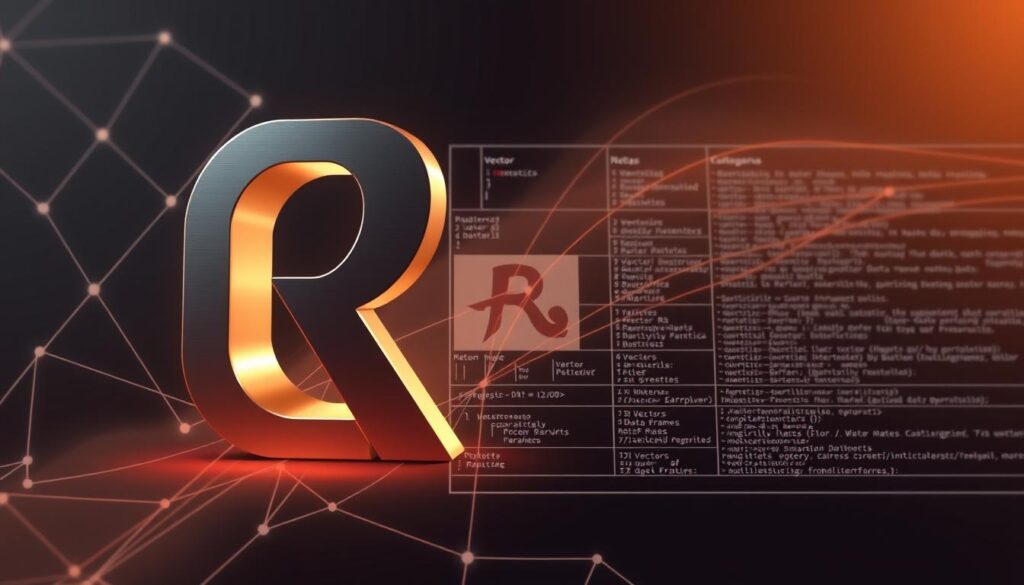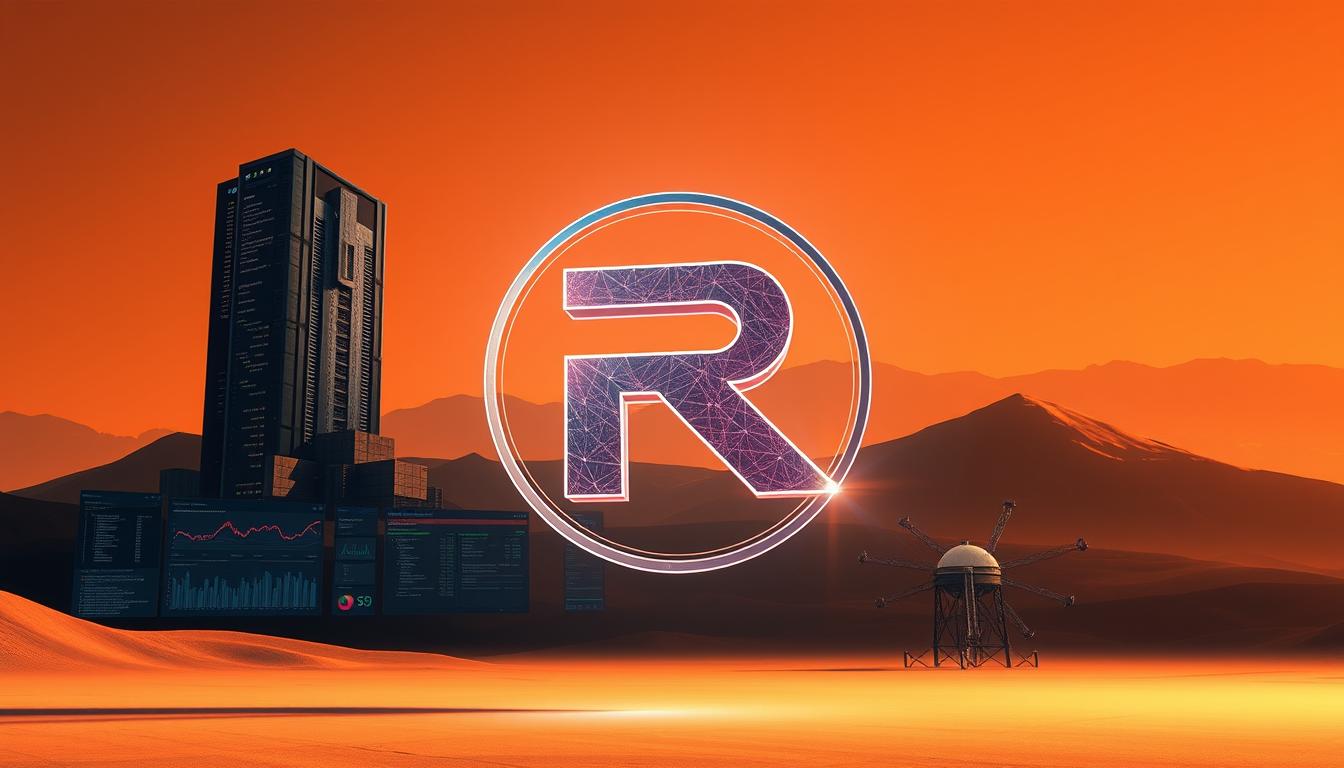The tech world is changing fast with R technology. It’s making a big difference in how we look at and use data.
New breakthroughs in R technology have led to unprecedented growth. It’s now used in many areas. This makes R technology key in the tech world, pushing for new ideas and better ways of working.
Knowing the newest in R technology is vital. It helps both professionals and companies to keep up in the fast-paced tech field.
Understanding R Technology Fundamentals
R technology is a top programming language for data analysis and statistical modeling. It’s widely used in the data science world because of its strong features and flexibility.
To really understand R technology, you need to know its main parts. At its heart, R is a language made for statistics and data visualization. It’s open-source, so anyone can use it. It also has many libraries and packages for different data analysis needs.
What Is R Programming Language?
R is a high-level, interpreted programming language great for statistics and data visualization. Its syntax is simple, making it perfect for new programmers and data analysts. R offers many statistical methods, like linear and nonlinear models, and data visualization tools.

R is also very customizable, letting users make their own functions and packages. This has led to a huge number of packages that can be easily added. This greatly increases R’s capabilities.
The Evolution of R Technology
R technology has changed a lot since it started. Ross Ihaka and Robert Gentleman created it in 1993 as a free alternative to S. It has become more popular over time, thanks to its growing community and new features.
The coding community around R has been key to its growth. They’ve added many packages and libraries. Now, R is used in many areas, from research to business data analysis. It’s seen as a key tool in data science.
Getting Started with R Technology
Starting your journey with R technology is easy. You just need to follow a few simple steps. These steps will help you learn more about R.
Installing R and RStudio
The first thing to do is install R and RStudio. R is the programming language, and RStudio is a tool that makes working with R easier. To install R, go to the R website and download the latest version for your computer.
After installing R, download and install RStudio from its official website.

Essential R Packages for Beginners
After installing R and RStudio, learn about essential R packages. These packages help you do more with R. For beginners, you need ggplot2 for graphs, dplyr for data work, and tidyr for cleaning data.
To install these packages, use the install.packages() function in R.
Writing Your First R Script
Now, it’s time to write your first R script. Open RStudio and create a new script. Start with simple things like setting variables and doing basic math.
As you get better, you can do more complex things like analyzing and visualizing data. This hands-on practice is key to learning R.
By following these steps, you’ll quickly become good at R technology. This will improve your skills in software development and data analysis.
Latest Advancements in R Technology
The latest in R technology is changing data analytics. These updates are making R better and using it in more places.
New R Packages and Libraries in 2023
New R Packages and Libraries in 2023
In 2023, new R packages and libraries have come out. They’re making a big difference in data analytics. These include better tools for seeing data, learning from it, and getting it ready.
- Packages that make data visualization easier, helping us understand complex data.
- Libraries that improve machine learning, leading to more accurate predictions.
- Tools that make data cleaning and manipulation faster, saving time.
Performance Improvements in Recent Versions
Performance Improvements in Recent Versions
Recent R versions have seen big performance boosts. These changes help with big data and complex tasks. Now, R is a strong choice for big data work.
The updates include better memory use and faster operation. These are key for working with lots of data.
Integration with Cloud and Big Data Technologies
Integration with Cloud and Big Data Technologies
R technology is now working with cloud and big data. This lets users use cloud computing for their data needs.
By linking R with big data, users can work with huge data sets. They can do complex analytics and find insights that were hard to get before.
How to Perform Data Analytics with R
R is a top choice for data analytics, loved by many data scientists. It helps extract insights from data through several steps.
Step-by-Step Data Importing and Cleaning
Importing and cleaning data are key steps. R has tools like readr and readxl for different file types.
- Use read_csv() from readr for CSV files.
- For Excel files, use read_excel() from readxl.
After importing, cleaning is done with dplyr and tidyr. This includes fixing missing values and changing data formats.
| Operation | R Function | Description |
|---|---|---|
| Handling Missing Values | na.omit() | Omits rows with missing values |
| Data Transformation | mutate() | Creates new variables or transforms existing ones |
Creating Compelling Visualizations with ggplot2
Visuals are crucial for data insights. ggplot2 is a top tool in R for this.
To make a simple plot, start with ggplot(). Then add layers like geom_point() or geom_bar().
- Begin with ggplot(data, aes(x = variable1, y = variable2)).
- Add layers with geom_point() or geom_bar().
Conducting Statistical Analysis
R is great for statistical analysis too. This includes hypothesis testing and regression.
To do a t-test, use t.test(). For linear regression, lm() is the function.
| Analysis Type | R Function | Description |
|---|---|---|
| T-test | t.test() | Performs a t-test to compare means |
| Linear Regression | lm() | Fits a linear model |
Implementing Machine Learning with R
Machine learning in R lets data analysts create predictive models. These models help make business decisions. R is great for this because it has lots of libraries and a big community.
How to Build Predictive Models
To build predictive models in R, you need to prepare data, pick features, and train the model. Linear regression and decision trees are top choices for this.
- Data preparation: Cleaning and transforming data for modeling
- Feature selection: Identifying relevant variables for the model
- Model training: Using algorithms like linear regression or decision trees
Clustering and Dimensionality Reduction Techniques
R has many tools for clustering and reducing data size. k-means clustering and Principal Component Analysis (PCA) are key. They help find patterns and simplify big datasets.
- K-means clustering for grouping similar data points
- PCA for reducing the dimensionality of datasets
Model Evaluation and Optimization
It’s important to check and improve machine learning models. Cross-validation and hyperparameter tuning are key. They help see how well a model works and make it better.
Using these methods, data scientists can make strong machine learning models in R. These models help businesses grow and make better decisions.
R for Artificial Intelligence Applications
R technology has made big strides in artificial intelligence, focusing on natural language processing and neural networks. Its ability to handle complex data and a wide range of libraries make it perfect for AI tasks.
With libraries like Keras and TensorFlow, R has become a key player in deep learning. These tools make it easier for data scientists to work on AI projects without getting bogged down in details.
Building Natural Language Processing Solutions
Natural Language Processing (NLP) is a key part of AI, helping computers understand and interact with humans. R has packages like tm and tidytext that make NLP easier. These tools help with text cleaning, analyzing feelings in text, and finding topics.
“The tidytext package provides a tidy framework for text analysis, making it easier to integrate NLP tasks with other data analysis workflows.”
R’s NLP tools are used in many areas, like analyzing customer feedback and monitoring social media. This helps businesses understand what people are saying about them.
| NLP Task | R Package | Description |
|---|---|---|
| Text Preprocessing | tm | Provides functions for cleaning and preprocessing text data. |
| Sentiment Analysis | tidytext | Enables sentiment analysis using various lexicons and methods. |
| Topic Modeling | topicmodels | Offers tools for topic modeling using Latent Dirichlet Allocation (LDA). |
Implementing Neural Networks with Keras and TensorFlow
R works well with Keras and TensorFlow for building complex neural networks. Keras makes it easy to create deep learning models. TensorFlow handles the heavy lifting in computation.
To build a neural network in R with Keras, follow these steps:
- Install and load the Keras package.
- Prepare the data for training.
- Define the neural network architecture.
- Compile and train the model.
- Evaluate the model’s performance.
Using Keras and TensorFlow in R makes building neural networks simpler. This is great for those who don’t have a lot of deep learning knowledge.
As AI keeps growing, R’s importance in advanced analytics and machine learning will only get bigger. R’s skills in NLP and deep learning help professionals solve tough problems and drive innovation in many fields.
Real-World Applications of R Technology
R technology is making a big impact in many fields, like finance and healthcare. It’s great for analyzing data and helping businesses and researchers.
Finance and Business Analytics
In finance, R helps with risk management, portfolio optimization, and predictive modeling. Banks and financial companies use R to understand big data, spot trends, and make smart investment choices. For example, R’s quantmod and PerformanceAnalytics libraries are key for financial modeling and analyzing performance.
Businesses also use R for market research and customer segmentation. By looking at customer data, companies can learn about what people like and who they are. This helps them create better marketing plans.
Healthcare and Bioinformatics
In healthcare, R is key for clinical research and epidemiological studies. Researchers use R to study clinical trial data, find patterns, and make important discoveries. The survival package in R is a big help for survival analysis in medical studies.
Bioinformatics is another area where R shines. It’s used for genomic data analysis, protein structure prediction, and systems biology. Bioconductor, a collection of R packages, offers tools for working with genomic data. This helps in studying cancer genomics, gene expression, and more.
R technology is flexible and keeps getting better with new packages and libraries. As technology advances, R will keep being a vital tool for analyzing data and making decisions.
Best Practices for R Development
Following best practices in R development is key to creating strong, efficient, and growing codebases. As R keeps evolving, sticking to established guidelines is more crucial than ever. This ensures developers can make high-quality software.
Code Organization and Documentation
Effective code organization is at the heart of R development. It means setting up projects in a clear way, using meaningful file names, and keeping a consistent coding style. This makes the project easier to manage and understand.
Documentation is also vital. It helps developers grasp the code’s purpose and makes teamwork smoother. It’s important to use clear and concise comments and keep documentation up to date.
| Best Practice | Description | Benefit |
|---|---|---|
| Consistent Coding Style | Adhering to a uniform coding style throughout the project. | Enhances readability and maintainability. |
| Clear Documentation | Maintaining accurate and up-to-date documentation. | Facilitates understanding and collaboration. |
| Logical Project Structure | Organizing projects in a structured and logical manner. | Improves navigation and efficiency. |
Collaborative Development with Git and GitHub
Collaborative development is a big part of R software development. Using Git and GitHub lets many developers work together smoothly on projects.
Git’s version control helps track changes and manage code versions. GitHub adds to this by offering a place to share and manage code. This makes teamwork easier and more effective.
To get the most out of teamwork, R developers should follow best practices. This includes using descriptive commit messages and handling pull requests well.
Conclusion
R technology has become a key player in data analytics. It offers many features for different needs. From its basics to its latest updates, R technology is great at handling complex tasks.
It’s used in many fields like finance, healthcare, and business analytics. This helps make better decisions. R technology keeps getting better with new features and improvements.
Data analytics is vital for business success, and R technology is essential. It helps find new insights and build predictive models. Whether you’re experienced or new to data analytics, R technology is a valuable tool.
FAQ
What is R technology used for in data analytics?
R technology is key in data analytics. It’s used for data visualization, statistical modeling, and machine learning. It has tools like ggplot2 and caret for extracting insights from complex data.
How do I get started with R programming language?
Start by installing R and RStudio, a top IDE for R. Then, learn essential packages like dplyr and tidyr. Practice writing R scripts to get familiar with it.
What are some of the latest advancements in R technology?
New R packages and libraries have been developed. These include tools for deep learning and natural language processing. R has also seen performance boosts and better cloud and big data integration.
Can R be used for artificial intelligence and machine learning applications?
Yes, R is great for AI and machine learning. It’s used for predictive models, clustering, and neural networks. Libraries like Keras and TensorFlow make it easy to use deep learning frameworks in R.
What are some best practices for R development?
Keep your code organized and documented. Use version control systems like Git. Collaborate on GitHub. These practices make your R code easy to maintain and understand.
How is R technology applied in real-world scenarios?
R technology is used in finance, healthcare, and business analytics. It helps with data analysis, visualization, and modeling. This leads to data-driven decisions and business growth.
What are the benefits of using R for data analytics compared to other programming languages?
R is great for data analytics. It has many libraries and packages, is easy for statistical modeling, and has strong data visualization. Its flexibility and customizability make it a favorite among analysts and scientists.
How can I improve my skills in R programming and data analytics?
Improve your skills by working on real projects. Take online courses or attend workshops. Stay current with R technology and its uses in data analytics and machine learning.




